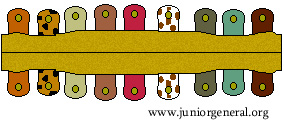
Sequence of Play:
1. Egyptians Move
2. Egyptians Shoot
3. Hittites Move
4. Charge into Melee
5. Melee
Movement:
All infantry units move 6", chariots move 12". Hittite chariots and all foot units are limited to wheels and obliques of 45 degrees. Egyptian chariots can move however they please.
Shooting:
Only archers and Egyptian chariots (including the Pharaoh) are allowed to shoot. They have a range of 12". Roll 1D6 for each archer base or two dice for each chariot base in range. Every 6 is a hit and one enemy base is removed. The Pharaoh hits on a 5 or 6. If any part of a unit is in range the entire unit may fire. Units that are engaged in melee may not fire, and may not be targeted.
Charge into Melee:
Both sides may charge into melee. This is the only way to get into hand-to-hand fighting. Foot units may charge up to 6", chariots may charge 12". Units may only charge if they can reach an enemy unit in front of them. If it matters, Hittites charge first.
Melee:
Each side rolls 1D6 for each base in the fight, or two dice for each chariot base. The Melee Table shows the number needed to score hits. Remove one enemy base for every hit. Both sides roll simultaneously. If both units still have stands left they remain engaged and fight again next turn.
- Unit Hit #
Archers 6
Infantry / Sherden Guards 5-6
Egyptian Chariots 5-6
Hittite Chariots 4-6
King / Pharaoh 4-6
Last Stand:
If a foot unit is reduced to one stand this last stand is removed immediately. This rule does not apply to chariots.
Leaders:
The King and Pharaoh may not be targeted individually. If they are attached to a unit they count as an extra base in melee. If the unit they are attached to loses bases in melee roll 1D6. If the roll is a 6 then the leader is eliminated.
The Egyptian Camp:
The Egyptian camp was a difficult place for chariots to fight, and the lure of plunder distracted the Hittite attackers. Chariots fighting a melee against an enemy in the camp roll one die per base, not two.
Flank Attacks:
Units that charge an enemy unit on the flank or rear gain an advantage. The flanked unit may only fight back with two bases if it's a foot unit, or one base if a chariot unit. This advantage applies only on the first turn of melee.
Crossing the River:
A unit crossing the river must end its move with the front rank of the unit in the middle of the river. This unit may not charge during this turn, and if charged by the enemy it may not fight back. These restrictions only apply during the turn they are crossing. On the next turn they may move and fight normally.
Fightin' for the Pharaoh Battle of Kadesh (1300 BC)
Back to Table of Contents -- Junior General Report # 5
Back to Junior General Report List of Issues
Back to MagWeb.com Magazine List
© Copyright 2004 by Matt Fritz.
This article appears in MagWeb.com (Magazine Web) on the Internet World Wide Web. Other articles covering military history and related topics are available at http://www.magweb.com